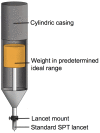The Lancet Weight Determines Wheal Diameter in Response to Skin Prick Testing with Histamine
- PMID: 27213613
- PMCID: PMC4877047
- DOI: 10.1371/journal.pone.0156211
The Lancet Weight Determines Wheal Diameter in Response to Skin Prick Testing with Histamine
Abstract
Background: Skin prick test (SPT) is a common test for diagnosing immunoglobulin E-mediated allergies. In clinical routine, technicalities, human errors or patient-related biases, occasionally results in suboptimal diagnosis of sensitization.
Objective: Although not previously assessed qualitatively, lancet weight is hypothesized to be important when performing SPT to minimize the frequency of false positives, false negatives, and unwanted discomfort.
Methods: Accurate weight-controlled SPT was performed on the volar forearms and backs of 20 healthy subjects. Four predetermined lancet weights were applied (25 g, 85 g, 135 g and 265 g) using two positive control histamine solutions (1 mg/mL and 10 mg/mL) and one negative control (saline). A total of 400 SPTs were conducted. The outcome parameters were: wheal size, neurogenic inflammation (measured by superficial blood perfusion), frequency of bleeding, and the lancet provoked pain response.
Results: The mean wheal diameter increased significantly as higher weights were applied to the SPT lancet, e.g. from 3.2 ± 0.28 mm at 25 g to 5.4 ± 1.7 mm at 265 g (p<0.01). Similarly, the frequency of bleeding, the provoked pain, and the neurogenic inflammatory response increased significantly. At 265 g saline evoked two wheal responses (/160 pricks) below 3 mm.
Conclusion and clinical relevance: The applied weight of the lancet during the SPT-procedure is an important factor. Higher lancet weights precipitate significantly larger wheal reactions with potential diagnostic implications. This warrants additional research of the optimal lancet weight in relation to SPT-guidelines to improve the specificity and sensitivity of the procedure.
Conflict of interest statement
Figures






Similar articles
-
[COMPARISON OF WHEAL SIZE INDUCED BY BIFURCATED NEEDLE® AND SMARTPRACTICE® PRICK LANCET].Arerugi. 2022;71(5):389-396. doi: 10.15036/arerugi.71.389. Arerugi. 2022. PMID: 35831164 Japanese.
-
Comparison of a new lancet and a hypodermic needle for skin prick testing.Allergy. 1983 Jul;38(5):359-62. doi: 10.1111/j.1398-9995.1983.tb04131.x. Allergy. 1983. PMID: 6614408 Clinical Trial.
-
[The comparison of reactions in skin prick test performed with the standardized lancet and the injection needle].Pol Merkur Lekarski. 2008 Jun;24(144):495-501. Pol Merkur Lekarski. 2008. PMID: 18702329 Polish.
-
[Skin tests for diagnostics of allergic immediate-type reactions. Guideline of the German Society for Allergology and Clinical Immunology].Pneumologie. 2011 Aug;65(8):484-95. doi: 10.1055/s-0030-1256476. Epub 2011 Aug 9. Pneumologie. 2011. PMID: 21830178 German.
-
The skin prick test.J Biol Regul Homeost Agents. 2018 Jan-Feb;32(1 Suppl. 1):19-24. J Biol Regul Homeost Agents. 2018. PMID: 29552869 Review.
Cited by
-
Debates in allergy medicine: Molecular allergy diagnosis with ISAC will replace screenings by skin prick test in the future.World Allergy Organ J. 2017 Sep 19;10(1):33. doi: 10.1186/s40413-017-0162-3. eCollection 2017. World Allergy Organ J. 2017. PMID: 28959378 Free PMC article.
-
Epinephrine auto-injector needle length: The impact of winter clothing.Allergy Asthma Clin Immunol. 2020 Apr 15;16:24. doi: 10.1186/s13223-020-00422-4. eCollection 2020. Allergy Asthma Clin Immunol. 2020. PMID: 32322286 Free PMC article.
-
International Consensus Statement on Allergy and Rhinology: Allergic Rhinitis.Int Forum Allergy Rhinol. 2018 Feb;8(2):108-352. doi: 10.1002/alr.22073. Int Forum Allergy Rhinol. 2018. PMID: 29438602 Free PMC article.
-
Robust automated reading of the skin prick test via 3D imaging and parametric surface fitting.PLoS One. 2019 Oct 21;14(10):e0223623. doi: 10.1371/journal.pone.0223623. eCollection 2019. PLoS One. 2019. PMID: 31634361 Free PMC article.
-
The shape of and applied weight on skin prick lancets critically affect the wheal size in the skin prick test.World Allergy Organ J. 2024 Jun 13;17(6):100915. doi: 10.1016/j.waojou.2024.100915. eCollection 2024 Jun. World Allergy Organ J. 2024. PMID: 38974945 Free PMC article.
References
-
- Gergen PJ, Turkeltaub PC, Kovar MG. The prevalence of allergic skin test reactivity to eight common aeroallergens in the U.S. population: results from the second National Health and Nutrition Examination Survey. J Allergy Clin Immunol. 1987;80: 669–679. - PubMed
-
- Charlotte G. Mortz and Andersen Klaus E. Allergic contact dermatitis in children and. Contact Dermatitis, 1999,. 1999; 121–130. - PubMed
-
- Gomes ER, Demoly P. Epidemiology of hypersensitivity drug reactions. Curr Opin Allergy Clin Immunol. 2005;5: 309–316. - PubMed
Publication types
MeSH terms
Substances
LinkOut - more resources
Full Text Sources
Other Literature Sources

